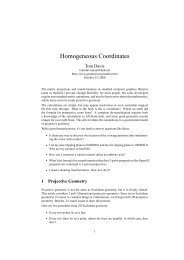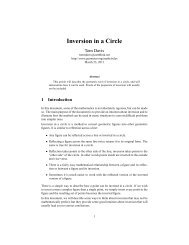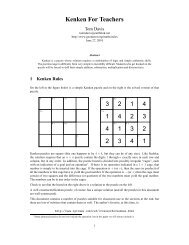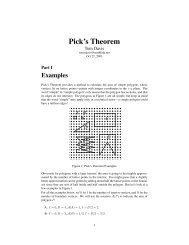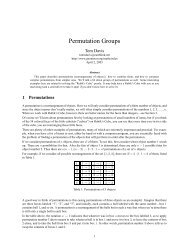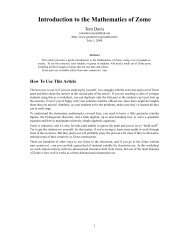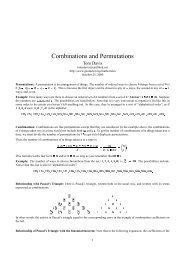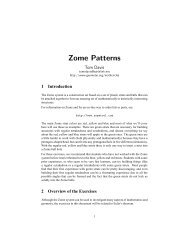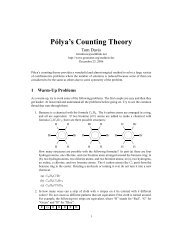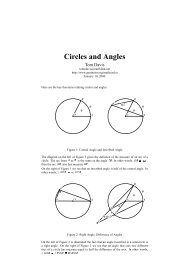Practical Calculation of Polygonal Areas - Tom Davis
Practical Calculation of Polygonal Areas - Tom Davis
Practical Calculation of Polygonal Areas - Tom Davis
Create successful ePaper yourself
Turn your PDF publications into a flip-book with our unique Google optimized e-Paper software.
<strong>Practical</strong> <strong>Calculation</strong> <strong>of</strong> <strong>Polygonal</strong> <strong>Areas</strong><br />
<strong>Tom</strong> <strong>Davis</strong><br />
tomrdavis@earthlink.net<br />
http://www.geometer.org/mathcircles<br />
January 30, 2006<br />
Abstract<br />
In this paper we will consider practical methods to find the area <strong>of</strong> irregular polygons. We will<br />
not provide pro<strong>of</strong>s <strong>of</strong> any <strong>of</strong> the formulas – they are readily available – but we will work out detailed<br />
examples <strong>of</strong> every technique.<br />
1 Simple <strong>Areas</strong><br />
There are nice formulas to calculate the area <strong>of</strong> certain simple polygons. The area <strong>of</strong> a rectangle is the<br />
length times the width; the area <strong>of</strong> a triangle is half the base times the height, and there are many others.<br />
D<br />
C<br />
I<br />
w<br />
h<br />
A<br />
l<br />
B<br />
G<br />
b<br />
K<br />
H<br />
Figure 1: Area Formulas for Simple Polygons<br />
In figure 1 the area <strong>of</strong> the rectangle ABCD is lw and the area <strong>of</strong> the triangle GHI is bh/2. Note that h<br />
is the perpendicular distance from point I to the line GH, and that b is the length <strong>of</strong> the segment GH.<br />
2 <strong>Polygonal</strong> Subdivision<br />
In many practical situations, the simple formulas do not apply: the four-sided figure is not a rectangle, or<br />
you have only the lengths <strong>of</strong> the three sides <strong>of</strong> a triangle but you do not have the altitude, or the figure is<br />
irregular and has more than four sides. When this occurs, the easiest solution is <strong>of</strong>ten to break the figure<br />
up into triangles, to calculate the area <strong>of</strong> each triangle, and then to add them to obtain the area <strong>of</strong> the entire<br />
polygon.<br />
A<br />
G<br />
B<br />
C<br />
H<br />
E<br />
F<br />
D<br />
Figure 2: Subdividing a Polygon<br />
1
This technique will work for any polygon. Figure 2 shows a very strange polgyon ABCDEF GH, yet its<br />
area is simply the sum <strong>of</strong> the areas <strong>of</strong> triangles AGH, ABG, BF G, BEF , BCE and CDE. In fact, any<br />
polygon with n sides can be subdivided into (n − 2) triangles using only existing vertices <strong>of</strong> the original<br />
polygon as illustrated in figure 2.<br />
When this subdivision strategy is used, we generally do not know the base and height <strong>of</strong> any <strong>of</strong> the<br />
triangles that form the subdivision, so what we need is a formula that tells us the area <strong>of</strong> a triangle, given<br />
the length <strong>of</strong> all three sides.<br />
3 Heron’s Formula<br />
If the lengths <strong>of</strong> the three sides <strong>of</strong> a triangle are a, b and c, then we can calculate the semiperimeter (half<br />
the perimeter) as follows: s = (a + b + c)/2. Heron’s formula gives the area A <strong>of</strong> the triangle:<br />
A = √ s(s − a)(s − b)(s − c).<br />
B<br />
5<br />
13<br />
A<br />
12<br />
C<br />
Figure 3: A 5 − 12 − 13 Right Triangle<br />
Let’s use Heron’s formula for a simple triangle where we already know the area. We’ll use the 5−12−13<br />
right triangle shown in figure 3. The area is easy to calculate in the usual way: the base (AC) is 12 and<br />
the height (AB) is 5. Remember that the height is the length <strong>of</strong> a side only in a right triangle. Thus the<br />
area is 5(12)/2 = 30.<br />
To use Heron’s formula, let a = 13, b = 12 and c = 5, so s = (a + b + c)/2 = (5 + 12 + 13)/2 = 15.<br />
The area A is:<br />
A = √ 15(15 − 13)(15 − 12)(15 − 5) = √ 15(2)(3)(10) = √ 900 = 30.<br />
Heron’s formula, <strong>of</strong> course, works for any triangle – not just right triangles, but the example above shows<br />
how to use it, and shows that it gives the right answer in at least one case. Note also that usually the<br />
square root does not turn out to be a round number.<br />
4 The Law <strong>of</strong> Cosines<br />
We will need to use the law <strong>of</strong> cosines in the next section.<br />
The law <strong>of</strong> cosines allows us to calculate the third side <strong>of</strong> a triangle if we know the lengths <strong>of</strong> the other<br />
two sides and <strong>of</strong> the angle between them. In the triangle in figure 4 we can calculate the length <strong>of</strong> the side<br />
AB if we know the lengths <strong>of</strong> BC and CA. In the formula we will call the length <strong>of</strong> AB, BC, and CA<br />
c, a, and b, as in the figure. (If this seems confusing, the a is the length <strong>of</strong> the side opposite the angle A,<br />
b is the length <strong>of</strong> the side opposite angle B, and so on.)<br />
If γ is the measure <strong>of</strong> angle BCA, then the law <strong>of</strong> cosines states that:<br />
c 2 = a 2 + b 2 − 2ab cos γ,<br />
2
B<br />
c<br />
A<br />
a<br />
b<br />
γ<br />
C<br />
Figure 4: The Law <strong>of</strong> Cosines<br />
or<br />
c = √ a 2 + b 2 − 2ab cos γ.<br />
We will see an example <strong>of</strong> the use <strong>of</strong> the law <strong>of</strong> cosines in the next section.<br />
5 <strong>Areas</strong> <strong>of</strong> Quadrilaterals<br />
If we know the lengths <strong>of</strong> the four sides <strong>of</strong> a quadrilateral, we cannot, in general, compute the area.<br />
A<br />
D’<br />
B<br />
D<br />
A’<br />
C’<br />
C<br />
B’<br />
Figure 5: Two Quadrilaterals with Equal Sides<br />
Figure 5 shows why. The two quadrilaterals ABCD and A ′ B ′ C ′ D ′ have equal-length sides, but the areas<br />
are obviously different. In other words, AB = A ′ B ′ , BC = B ′ C ′ , CD = C ′ D ′ and DA = D ′ A ′ .<br />
To make it obvious why the area can vary, imagine taking four sticks <strong>of</strong> the appropriate lengths and<br />
connecting them with pivots at the ends so the shape can be flexed. For a triangle, only one shape is<br />
possible, but once there are more than three sides, there is flexibility, and changing the angles can change<br />
the area. The extreme situation is a figure with four equal sides. It could be a square, or you can squash it<br />
into a thinner and thinner diamond and can make the enclosed area as close to zero as you would like.<br />
The bottom line is that to find the area <strong>of</strong> a quadrilateral, you need more than just the lengths <strong>of</strong> the four<br />
sides. If you know one <strong>of</strong> the diagonal lengths, then the problem is simple, since this effectively divides<br />
the region into two triangles, and you know the lengths <strong>of</strong> all three sides <strong>of</strong> each, so Heron’s formula can<br />
be applied twice and the results added.<br />
You can also work out the area if you have any one <strong>of</strong> the four angles. That’s because you can find the<br />
length <strong>of</strong> the diagonal opposite the angle by using the law <strong>of</strong> cosines. As an example, let’s work out the<br />
area <strong>of</strong> the quadrilateral displayed in figure 6 where the angle at A is 109 ◦ and the sides have the lengths<br />
100 feet, 120 feet, 110 feet and 95 feet as shown in the figure.<br />
We want to find the length <strong>of</strong> side BD. The law <strong>of</strong> cosines tells us that:<br />
BC = √ 100 2 + 120 2 − 2 · 100 · 120 cos 109 ◦ .<br />
3
A<br />
100<br />
109<br />
120<br />
D<br />
B<br />
95<br />
C<br />
110<br />
Figure 6: Area <strong>of</strong> a Quadrilateral with an Angle<br />
The cosine <strong>of</strong> 109 ◦ is −.325568, so:<br />
BC = √ 10000 + 14400 − 24000(−.325568)<br />
= √ 24400 + 7813.64<br />
= √ 32213.64<br />
= 179.48<br />
which looks about right, according to the figure.<br />
Now, to calculate the area <strong>of</strong> the quadrilateral ABCD we have to find the area <strong>of</strong> two triangles. One has<br />
sides equal to 100, 120, and 179.48; the other has sides equal to 95, 110 and 179.48, so we will need to<br />
use Heron’s formula twice.<br />
For the first triangle, a = 100, b = 120, c = 179.48. First we need to find the semiperimeter s =<br />
(a + b + c)/2. For this triangle, s = 199.74. Heron’s formula tells us that the area A 1 <strong>of</strong> the first triangle<br />
is:<br />
A 1 = √ s(s − a)(s − b)(s − c)<br />
= √ 199.74(199.74 − 100)(199.74 − 120)(199.74 − 179.48)<br />
= √ 199.74(99.74)(79.74)(20.26)<br />
= √ 32184745<br />
= 5673.16<br />
The calculation is similar for the area A 2 <strong>of</strong> the second triangle using a = 95, b = 110 and c = 179.48,<br />
and it turns out to be A 2 = 4429.06. (It’s a good idea to try to work this one out yourself to make certain<br />
that you understand the process.) The total area <strong>of</strong> the quadrilateral is thus:<br />
A 1 + A 2 = 5673.16 + 4429.06 = 10102.22.<br />
Since the units on the sides were in feet, this will be the number <strong>of</strong> square feet.<br />
(If you need to convert to acres, 1 acre is equal to 43650 square feet, so for if the measurements above<br />
were for a parcel <strong>of</strong> land, its area, in acres, would be 10102.22/43560 = .232 acres.<br />
6 More Complex Polygons<br />
For the same reasons that you cannot calculate the area <strong>of</strong> a quadrilateral knowing only the lengths <strong>of</strong><br />
the four sides, you need more information than just the lengths <strong>of</strong> the sides for polygons with 5, 6, 7, . . .<br />
sides. For a 5-sided polygon, you need the lengths <strong>of</strong> two diagonals, or <strong>of</strong> two angles, or <strong>of</strong> a diagonal<br />
and an angle; in other words, two extra pieces <strong>of</strong> information. For a 6-sided polygon, you’ll need three<br />
extra pieces <strong>of</strong> information, and so on. If those pieces <strong>of</strong> information are the diagonals, the calculation is<br />
straightforward; if they are measures <strong>of</strong> angles, you may need to use the law <strong>of</strong> sines in addition to the<br />
law <strong>of</strong> cosines.<br />
4
7 Some Technical Details<br />
So far we have never stated exactly what we mean by a “polygon” and in fact it is somewhat difficult to<br />
define that term in a mathematically precise way. Can it have indentations? Can it have holes? Can it<br />
have multiple regions? Can the edges cross each other or touch other edges?<br />
For the results so far, holes, multiple regions, and indentations do not matter; as long as the area to be<br />
determined can be subdivided into triangles, everything up to now works. For the following two sections,<br />
however, we will not allow multiple regions or holes. A polygon, for the purposes <strong>of</strong> the rest <strong>of</strong> this<br />
article, is a set <strong>of</strong> vertices and line segments connecting them in order from the first to the last and then<br />
back to the first, such that none <strong>of</strong> the line segments cross another segment or touch any vertex other than<br />
the two vertices it is connecting.<br />
These polygons are allowed to have indentations, as long as the line segments making up the edges never<br />
touch. (Polygons without indentations are called “convex polygons”; polygons that are not convex are<br />
sometimes called “concave” or simply “non-convex”.<br />
8 <strong>Areas</strong> Based on Coordinates<br />
Sometimes you will be lucky enough to have coordinates <strong>of</strong> the vertices <strong>of</strong> the polygon. When this occurs,<br />
there is a very simple formula that yields the area.<br />
If the points, in order, around a polygon having n vertices have coordinates v 0 = (x 0 , y 0 ), v 1 = (x 1 , y 1 ),<br />
v 2 = (x 2 , y 2 ), . . . , v n−1 = (x n−1 , y n−1 ), then the following formula yields the area:<br />
A = 1 2 [(x 0y 1 − y 0 x 1 ) + (x 1 y 2 − y 1 x 2 ) + · · · + (x n−2 y n−1 − y n−2 x n−1 ) + (x n−1 y 0 − y n−1 x 0 )]. (1)<br />
In other words, there is a term for each pair <strong>of</strong> adjacent coordinates that “wraps around” to the first point<br />
(v 0 ) at the end.<br />
If we duplicate the first point, (v 0 ) and call it v n , so that v n = (x n , y n ) = (x 0 , y 0 ), then there is a very<br />
compact mathematical formula for the area, if you understand sigma-notation:<br />
A = 1 n−1<br />
∑<br />
(x k y k+1 − y k x k+1 ).<br />
2<br />
k=0<br />
(0,5)<br />
(0,0)<br />
(8,0)<br />
Figure 7: Area <strong>of</strong> a Right Triangle<br />
Let’s check this for a very simple example first, then a more complex example. For the simple example,<br />
let’s use the formula to find the area <strong>of</strong> the triangle illustrated in figure 7 with vertices having the following<br />
coordinates: v 0 = (0, 0), v 1 = (8, 0), v 2 = (0, 5). We will be able to check the calculation, since this is a<br />
right triangle with base 8 and height 5, so the area is 1 2 · 8 · 5 = 20.<br />
We will use equation 1 with x 0 = y 0 = 0, x 1 = 8, y 1 = 0, x 2 = 0 and y 2 = 5. Plugging these numbers<br />
5
into the equation yields:<br />
A = 1 2 [(x 0y 1 − y 0 x 1 ) + (x 1 y 2 − y 1 x 2 ) + (x 2 y 0 − y 2 x 0 )]<br />
= 1 [(0 · 0 − 0 · 8) + (8 · 5 − 0 · 0) + (0 · 0 − 5 · 0)]<br />
2<br />
= 1 2 [40] = 20. (3,3)<br />
(0,8)<br />
(-8,3)<br />
(-5,3)<br />
(3,3)<br />
(7,3)<br />
(2,-3)<br />
(-4,-8)<br />
(5,-6)<br />
(7,-7)<br />
Figure 8: A Complex Polygon with Coordinates<br />
Next, let’s look at a more complex example, illustrated in figure 8. This is a polygon with nine vertices,<br />
and we’ll assign names to them as follows:<br />
v 0 = (x 0 , y 0 ) = (3, 3)<br />
v 1 = (x 1 , y 1 ) = (−5, 3)<br />
v 2 = (x 2 , y 2 ) = (0, 8)<br />
v 3 = (x 3 , y 3 ) = (−8, 3)<br />
v 4 = (x 4 , y 4 ) = (2, −3)<br />
v 5 = (x 5 , y 5 ) = (−4, −8)<br />
v 6 = (x 6 , y 6 ) = (7, −7)<br />
v 7 = (x 7 , y 7 ) = (7, 3)<br />
v 8 = (x 8 , y 8 ) = (5, −6)<br />
When we plug these values into equation 1, we obtain:<br />
A = 1 [(3 · 3 − 3 · (−5)) + (−5 · 8 − 3 · 0) + (0 · 3 − 8 · (−8))<br />
2<br />
+(−8 · (−3) − 3 · 2) + (2 · (−8) − (−3) · (−4)) + (−4 · (−7) − (−8) · 7))<br />
+(7 · 3 − (−7) · 7) + (7 · (−6) − 3 · 5) + (5 · 3 − (−6) · 3)]<br />
= 1 [24 − 40 + 64 + 18 − 28 + 84 + 70 − 57 + 33]<br />
2<br />
= 84.<br />
This formula assumes that the vertices <strong>of</strong> the polygon are listed in counter-clockwise order around the<br />
polygon. In other words, if you were to walk around the polygon from v 0 to v 1 to v 2 and so on, the<br />
interior <strong>of</strong> the polygon would always be to your left.<br />
If you accidentally reverse the points and list them in clockwise order, you will obtain the same numerical<br />
value for the area, but it will be negative instead <strong>of</strong> positive.<br />
6
9 Pick’s Theorem<br />
Finally, sometimes all <strong>of</strong> the vertices <strong>of</strong> a polygon lie on points that have integer (whole-number) coordinates.<br />
Another way to think <strong>of</strong> this is that you have a grid <strong>of</strong> points spaced one unit apart both vertically<br />
and horizontally, and all <strong>of</strong> the vertices <strong>of</strong> the polygon lie on these grid points. In this very special case,<br />
Pick’s theorem can be applied.<br />
A<br />
B<br />
D<br />
F<br />
C<br />
E<br />
Figure 9: <strong>Polygonal</strong> Area Using Pick’s Theorem<br />
Figure 9 illustrates a number <strong>of</strong> examples. Pick’s theorem tells us that to find the area <strong>of</strong> any <strong>of</strong> these, we<br />
need only count the number <strong>of</strong> points completely inside the figure (I) and count the number <strong>of</strong> points that<br />
lie on the boundary <strong>of</strong> the figure (B) and the area is given by the formula: A = I + B/2 − 1.<br />
The following table shows the values <strong>of</strong> I, B and I + B/2 − 1 for each <strong>of</strong> the polygons in the figure. It<br />
is easy to check that the result is accurate for many <strong>of</strong> them:<br />
I B I + B/2 − 1<br />
A 0 4 1<br />
B 0 3 1/2<br />
C 28 26 40<br />
D 7 12 12<br />
E 22 24 33<br />
F 9 26 21<br />
7





